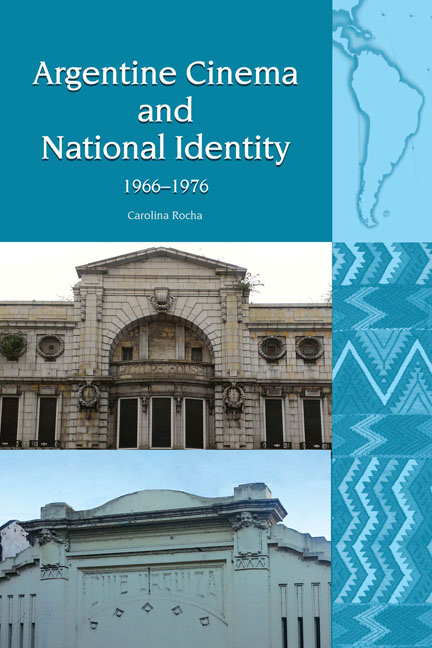Book contents
- Frontmatter
- In Memory of Paulina Piselli (1937–2017)
- Contents
- Acknowledgements
- Introduction
- Section I Argentine History and National Cinema, 1955–1976
- 1 Political and Social Tensions in Post-1955 Argentina
- 2 Argentine Cinema in the Late 1950s and Early 1960s
- 3 Argentine Cinema, 1966–1973
- 4 Argentine Cinema, 1973–1976
- Section II The Cinematic Gauchesque
- Section III Representing Founding Fathers
- Conclusion
- Bibliography
- Index
2 - Argentine Cinema in the Late 1950s and Early 1960s
from Section I - Argentine History and National Cinema, 1955–1976
- Frontmatter
- In Memory of Paulina Piselli (1937–2017)
- Contents
- Acknowledgements
- Introduction
- Section I Argentine History and National Cinema, 1955–1976
- 1 Political and Social Tensions in Post-1955 Argentina
- 2 Argentine Cinema in the Late 1950s and Early 1960s
- 3 Argentine Cinema, 1966–1973
- 4 Argentine Cinema, 1973–1976
- Section II The Cinematic Gauchesque
- Section III Representing Founding Fathers
- Conclusion
- Bibliography
- Index
Summary
The following examination of Argentine cinema is guided by Valentina Vitali and Paul Willemen's statement that ‘both as an industry and a discursive practice, cinema is an adjunct of capitalism’ (2006, 7). One important consideration to bear in mind is that during this period Argentine cinema did not enjoy a hegemonic position even domestically, since it competed with Hollywood films. To offset this competition, the Argentine state persistently sought to protect national film production through several laws, the most crucial of which was Law 62/57. Nevertheless, in the transition from the studio system to independent filmmaking, the Argentine film industry enjoyed uneven success in its attempt to gain a considerable share of the domestic market. Through trial and error, the state, directors, and producers came up with different solutions to strengthening the production and circulation of national films, which in many cases were resisted by exhibitors and distributors. Nevertheless, during this period, cinema constituted an important part of Argentine cultural life, as is evident in the opinions and debates that it generated. To understand the challenges and strengths of Argentine cinema, it is necessary to begin in the mid-1950s.
Around the middle of that decade, the regulation of Argentine cinema changed dramatically. The state allowed the entrance of unlimited foreign films even though Law 16,688 of 1950 stipulated the exhibition of national films for 26 weeks per year and left the remaining 26 weeks to the screening of foreign films (Kriger, 2009, 61–67). This legislation had two unexpected outcomes: one was a decrease in cinema attendance among the Argentine public (Falicov 2007, 29); the other, closely related to the diminishing audiences, was the bankruptcy of many Argentine studios that had financed and produced films in the previous decades; only a handful—Argentina Sono Film, Artistas Argentinos Asociados, and General Belgrano—remained in business (Maranghello, 1984, 94). Other factors that negatively affected the Argentine film industry were the considerable increase in production costs, the loss of other markets, and competition with foreign films (‘La producción,’ 1966, 93). In addition, the Revolución libertadora adversely impacted film production as it emphasized a climate of disorientation, made even more pronounced by tensions between Peronists and anti-Peronists (Martínez, 1961, 13).
- Type
- Chapter
- Information
- Argentine Cinema and National Identity (1966–1976) , pp. 27 - 40Publisher: Liverpool University PressPrint publication year: 2018

